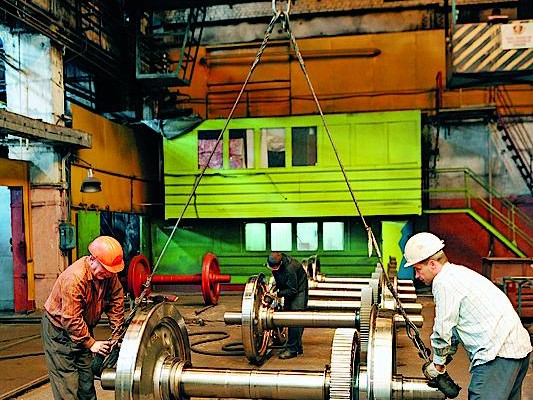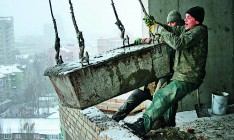Business
revivalLuhanskteplovoz resumes its operation. Russian customers will fully load it with orders

Ukraine’s largest manufacturer of diesel locomotives LuhanskTeplovoz PJSC (LTZ) resumes its operation, informed the secretary of the company’s General Director Petro Karpov in a conversation with Capital yesterday. As of today, not all the employees have returned to work, but for the management it’s business as usual. This became possible after the supply of energy was resumed in the city. The LTZ will resume production at full capacity on October 1, the company’s representative assured. No other details of the further operation of the plant were disclosed.
The conveyor at Luhanskteplovoz was stopped in August after the power plant supplying electricity to the company was damaged. General Director of Transmashholding (TMH, Russia; controls the LTZ) Andrei Andreyev then said that recovery would take a month. However, at the beginning of September the management of the Russian Railways (RZhD) announced that it would transfer its orders from the LTZ to Russian enterprises. At the same time, representatives of the company acknowledged that there were no substitutes for the locomotives produced in Luhansk.
Today, Russian railway companies still have high hopes for the Ukrainian enterprise. Head of the External Relations Department of TMH Artyom Ledenev said that LTZ would continue to operate within the framework of the existing agreements. Luhanskteplovoz did not lose the contract approved at the beginning of 2014, and Russian Railways will buy all the units that the company will be able to produce this year.
Of course, the downtime of the conveyor at the LTZ will have its consequences and it will be impossible to execute the annual contract in full, but the missing locomotives will be ordered at Russian enterprises, which have available capacities,” said Vice President of Russian Railways Anatoly Meshcheryakov. Prior to the downtime the LTZ worked at its full capacity, so at present it is not possible to close the gap in the orders, according to Meshcheryakov.
This year the LTZ planned to supply its customers with products in the amount of UAH 4.55 bn, which is 1.5 times more than in 2013 and produce 332 sections of locomotives and 28 electric locomotives. Over the period of two months of downtime (August – September) the company failed to supply 50 sections of locomotives. The company’s lost profits amounted to approximately UAH 700 mn, according to estimates of Senior Analyst at Art Capital Investment Capital Oleksiy Andriychenko.
Meshcheryakov hopes that the LTZ will be able to gather its staff quickly and reach the former rate of production as soon as possible, as his company needs the equipment from Luhansk. Andriychenko believes that the plant is most likely to have all the necessary components, which in terms of such bookings are usually purchased in advance, particularly since Luhanskteplovoz traditionally reached the maximum rate of production in the second half of the year.
Russians prefer not to predict the future prospects of the Ukrainian enterprise, but it is clear that at present they cannot manage without its products.
Indeed, LTZ is one of the main suppliers of locomotives in Russia. In the first half of 2014 the share of two- and three-unit locomotives from the Luhansk enterprise was 18% of the Russian Railway’s total volume of purchases of such rolling stock and in purchases of mainline freight locomotives – 88%, Andriychenko calculated.
There were plans of acquiring 5,040 locomotives, or an average of 721 per year, in 2014–2020, according to the federal target program Development of the Russian Transport System (2010–2020). In addition, at the end of last year the Ministry of Transport of the Russian Federation proposed to increase this number by 22% to 6,160 locomotives (880 per year). The outlined decrease of industrial growth in Russia at the beginning of 2014, which by the end of the year will turn into decline, as well as the downtime at Luhanskteplovoz, forced Russian Railways to review the investment program for the next three years. Now the expected purchase in 2014 is 629 locomotives, and in 2015-2016 – 450 units per year.
However, according to Andriychenko, the decline will be temporary, as the average age of locomotives that Russian Railways has is more than 27 years, while the regulatory standard is 35 years. So, three years from now the company will have to renew the active purchase of locomotives or face a reduction of its traction fleet, seeing as the Russian Railways planned to lower the average age of locomotives from 27 to 20 years by 2030.
So, most likely in the next several years LTZ will be fully loaded. Moreover, Ukrainian locomotives are cheaper than similar Russian products. This suggests that the shareholders of the Luhanskteplovoz will continue to develop the company, assured Andriychenko. The domestic market should also not be disregarded: Ukraine’s Ministry of Infrastructure plans to expand its portfolio of orders to domestic enterprises, including LTZ. In order to achieve this, Ukraine is ready to attract UAH 12 bn against state guarantees.






 of the agreement of syndication with Financial Times Limited are strictly prohibited. Use of materials which refers to France-Presse, Reuters, Interfax-Ukraine, Ukrainian News, UNIAN agencies is strictly prohibited. Materials marked
of the agreement of syndication with Financial Times Limited are strictly prohibited. Use of materials which refers to France-Presse, Reuters, Interfax-Ukraine, Ukrainian News, UNIAN agencies is strictly prohibited. Materials marked  are published as advertisements.
are published as advertisements.